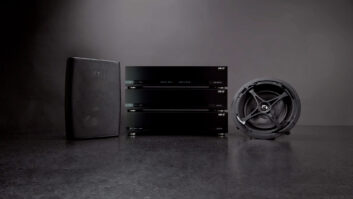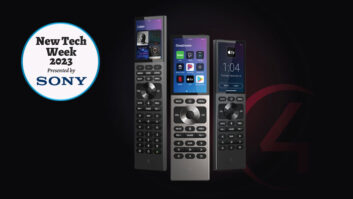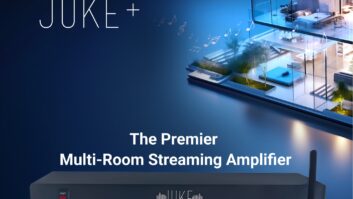“Exclusive, first-look, hands-on review.”
You want to know how to quickly get an equipment reviewer’s attention? It’s that. When I got a call from my friends at Caster Communications saying they had been working with a new client made up of industry vets that was ready to launch a new system geared entirely to the custom channel, and that they would like to send me the first system for review, well, it was an offer I couldn’t refuse.
The new company is AVA, and they are coming to market with two different products: a streaming audio system and a new handheld touchscreen controller.
Wireless audio systems are likely a part of your business, but outside a few exceptions from Bang & Olufsen, Devialet, Naim, or B&W, this isn’t really a category that has seen an emphasis on premium sound quality or luxury design. The typical offerings are good enough from a style and performance standpoint of solving the issue of adding audio to a room that didn’t — or couldn’t — be pre-wired for a more traditional audio distribution system.
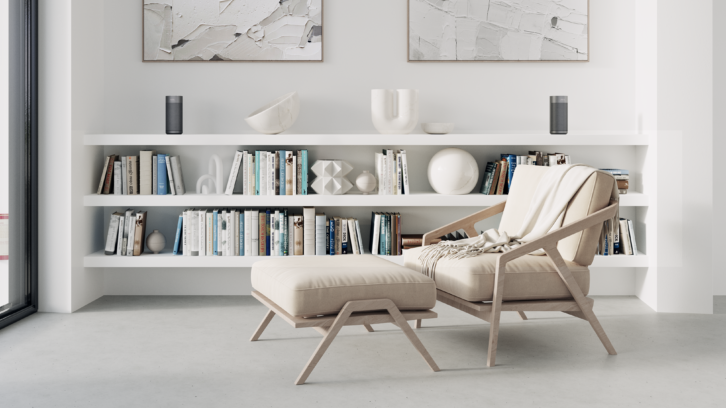
Instead of the traditional single-speaker approach adopted by most streaming audio manufacturers, AVA has designed and engineered its solution as a 2.1 system with the “mission to put proper stereo back into people’s homes.” As a system, it is designed to deliver fuller, richer sound with true stereo and accurate imaging, reproducing the audio experience intended by the artist and sound engineers.
In addition — and in line with the company’s pedigree — AVA is also coming to market with the new RX1 remote control; a high-performance handheld touchscreen that just oozes European sleekness, style, and cool. With quad core processing, the RX1 is one of the most powerful handheld Android-based devices you can get, and it makes a compelling offering regardless of your preferred automation system: Control4, Savant, Crestron…you name it.
Need more enticing? AVA is focusing exclusively on the professional installer channel. They want their CI dealer-channel partners to have products that deliver on experience, performance, and margin.
The AVA Team
Launching a company into the AV space takes a lot of engineering and know-how, and the team behind AVA has been there and done that, which certainly gives them a bunch of cred from the get-go, with three of AVA’s co-founders including Ted Haeger, Patrick Domenig, and Raphael Oberholzer. If you’re a Control4 dealer, these names — and the products they’ve been involved with — likely ring a bell.
Haeger, AVA’s chief customer officer, was C4’s VP of education and support, and if you took the online Pakedge PCNA certification course, it was Ted’s voice — and jokes (he apologizes!) — you were listening to.
Domenig, AVA’s chief operating officer and co-founder, was head of community management at NEEO before becoming a senior program manager at Control4.
Oberholzer, AVA’s CEO and co-founder, has been obsessed with creating better user experiences for over 20 years. In 2014, he founded NEEO, the remote control and home automation company. NEEO was acquired by Control4 in 2019, and Oberholzer became senior director, products. Shortly after, he left the company to pursue his next passion project, which brings us back to AVA.
What the AVA team really understands is UI and customer experience, thus the RX1 is a natural evolution of their core competencies and their design work with NEEO. Inspired by Revox, a well-established Swiss audio designer and manufacturer with deep audio engineering chops, Oberholzer nurtured a partnership between the two teams, and AVA was born. By working with Revox and using existing hardware and audio engineering, AVA refined the user experience and system performance to bring a premium streaming audio solution to the American market.
Speaker Install
There are two speakers in AVA’s lineup, the active A1 and the passive P1, along with the B1 bass module — and together these comprise two different 2.1-channel systems, either Active-Active or Active-Passive.
Visually, the A1’s design is simple and clean, with a very understated AVA logo and the front half finished in a micro-perf metal grille. The speaker’s cylindrical design and formfactor has a strong resemblance to a first-generation Amazon Alexa. The top of the AVA A1 has some capacitive touch controls for basic operation (volume +/-, play/pause, and preset selection), along with some status LEDs. The speaker stands just under 8.75 inches, has a diameter just under 4 inches, and weighs in at 2.6 pounds.
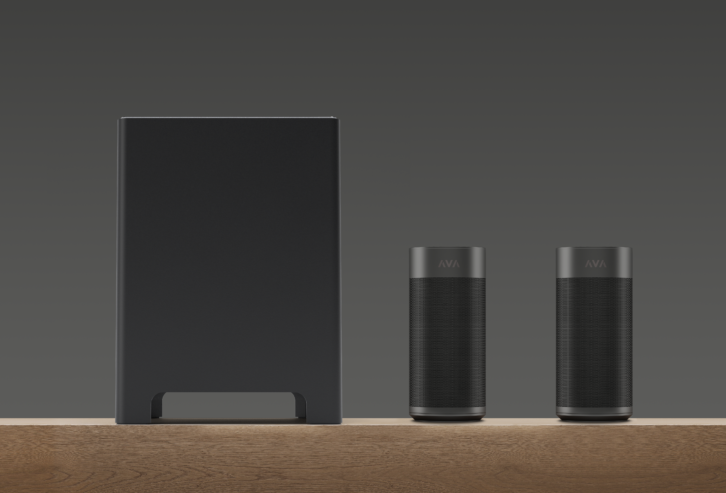
The B1 bass module is similarly restrained in design, having a clean matte-black finish around the sides with a glossy black top. It has a near 12-inch base and stands roughly 16.5 inches high. It has nice fit-and-finish, and feels like a nice bit of kit, weighing in just under 26 pounds. The B1’s down firing 8.75-inch bass driver is powered by a 240-watt amplifier.
While the audio performance is identical between the Active-Active and Active-Passive configurations, the installation — and price — is different and might influence which you suggest. Retail pricing for the dual A1 and B1 Active-Active system is $3200, while the Active-Passive A1, P1, and B1 system is $2700. AVA sent me two A1s, a P1, and a B1 to experience the full setup and install experience with both combinations.
With the Active-Active system, both A1 speakers connect to power, but the connection between them is wireless, pairing with the KleerNet radio protocol that “delivers studio audio quality and resists interference better than Wi-Fi,” according to AVA.
When using the Active-Passive system, the P1 doesn’t require a power connection, however there is a physical cable connection between the two speakers, with the P1 driven by a secondary 20-watt amplifier aboard the A1.
In both systems the B1 simply connects to power and pairs wirelessly via KleerNet to the primary A1 in the system. While there are a variety of connections and controls on the B1’s back panel (volume, phase, crossover, etc.), none of these are functional when paired with an A1.
As with any wireless audio system, step one is getting the primary speaker powered up and onto the network, and the A1 supports either wired or wireless. Since the most likely use-case will be Wi-Fi, that’s the route I took. You put the speaker into pairing mode by pressing and holding the music and + buttons on top of the speaker, which creates a local ad-hoc network for you to connect to. After connecting, you open the AVA app (iOS and Android) and choose the Wi-Fi network you’ll be connecting to (2.4 and 5 GHz) and give the speaker a name. Pairing to a second A1 or the B1 is even simpler.
Even though I have a pretty solid Wi-Fi network throughout my home courtesy of four Luxul MN-10 mesh nodes, the A1’s wants a strong Wi-Fi signal. For example, in my kitchen where my iPhone 11 showed full-bars on my 5 GHz network, an A1 barely registered a connection and had streaming issues. Switching over to the 2.4-band produced just two bars on the A1, but was enough to function without issues.
Connection-wise, besides power and LAN, the A1 has a 3.5mm input for an analog source, a USB for service, and the Phoenix-style connector for the P1. Both A1 and P1 speakers also have an M6 thread for wall mounting.
Remote Setup
Looking at AVA’s RX1, you can’t help but see callbacks to Neeo’s heritage, but with a clear design and performance evolution. Imagine a Lamborghini Huracan looking back on a Diablo. “Yeah, you were cool at the time. But look at me now!”
The $1299 remote (available in black or silver finish) has an aluminum alloy body with a slender profile that feels solid and balanced in the hand, and its front side is dominated by a large 4.5-inch, scratch-resistant, color touchscreen with 480 x 1170 resolution and 280 ppi density. Like the Neeo, the remote sits vertically in its charging dock, and, right up until I tried it, I would have sworn they actually used the same charging dock (they don’t), with the RX1 being a tad thicker and shorter than the Neeo.
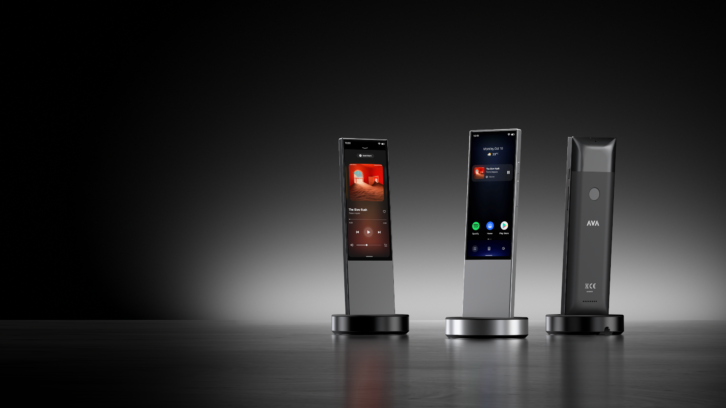
I’m an iOS guy, so I’ve never actually set up an Android phone, but I imagine the initial RX1 setup is a very similar process. The remote runs Android 11 OS, and with 32 Gigs of onboard storage, and four cores running at 2 GHz, so think of it as a powerful, purpose-built Android device.
AVA claims the RX1 is the world’s first Google-certified remote that offers you the full power of the Google Play Store, and with the Play Store on board, it can install and run any Android app, giving you a fully native experience of any Android-controllable device. Load the Control4 app and you have a full-blown C4 touchscreen experience, including access to intercom features. Ditto with Savant, Crestron, or URC. Check your Ring cameras, run your favorite music app, adjust your Lutron lights, navigate your Kaleidescape collection, and, sure, even control your Sonos, HEOS, or Bluesound systems. If it has an Android app, this remote can load it and run it.
Of course, with its tall-and-skinny screen, some of the touchscreen buttons can be pretty small and tightly packed, making it less-than-ideal as a TV controller, though I found the gesture control built into the C4 and Kaleidescape apps did a nice job of D-pad navigation. But this will likely prove frustrating as a daily TV driver, and isn’t a use that AVA suggests.
It also features Bluetooth 5, NFC, an accelerometer, an integrated rear-panel fingerprint sensor, GPS, a microphone, and a speaker. And, yes, it can run Google Assistant and be a voice remote. Remember, the RX1 is essentially a powerful, purpose-built Android device with numerous features in common with your phone.
Performance
I received my review speakers before having any communications with AVA, so I did what I always do: I ripped the packages open and started connecting things. Hey, this isn’t my first rodeo — let’s ride!
My initial experience with the AVA speakers was with a single A1 and, frankly, I was a bit underwhelmed. On its own, I found the sound to be a bit chesty, and it lacked range and extension, sounding quite thin. Audio felt “confined” to the speaker, and didn’t have much sense of space. One of my favorite bass-check tracks is “High Roller” by The Crystal Method, and let’s just say the big bass notes were totally missing.
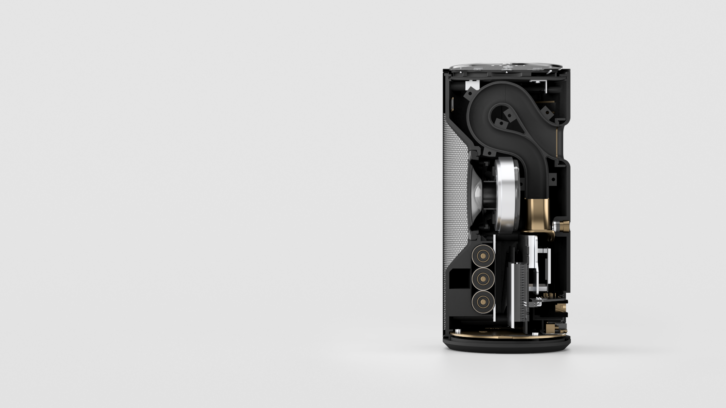
Next, I connected the A1 to the P1 and immediately noticed an improvement. Together, the pair had more output, and delivered that jazzy, upper-bass register with enough weight that a standing bass or cello carried some audible heft. They also imaged really nicely, locking vocals between them, and sound felt like it started expanding a bit beyond the physical boundaries of the speakers. Music started having a more dimensional quality and far better presence.
Finally, I added the B1 and experienced the entire 2.1 system the way AVA intended, and that’s when things started coming together. Like a puzzle, AVA’s sonic image isn’t complete until all the pieces — especially the bass module — are there. The individual speakers are certainly stronger together as a system; delivering more output, full-range sound, and impact and low-end presence than when used individually. Now the speakers were actually delivering rich and layered audio that was enjoyable, particularly with detailed and crisp highs, beautiful shimmering cymbals, and delicate brush strokes.
As I listened, I really started appreciating the clarity of the audio, and how non-fatiguing the sound was. While the soundstage isn’t huge, when working in concert the AVA system produces sound that certainly extends beyond the boundaries of the physical speakers. And I started noticing the little details the speakers deliver that stand out; sounds like the decay of a cymbal or bell, the textural resonance of a string pluck, or the air and space around a recording. You also enjoy that nice bit of natural reverb that acoustically defines and establishes a recording space and that gives life to music such as The Cowboy Junkies’ Trinity Sessions. If I were given just three adjectives to describe the AVA sound, they wound be “articulate,” “detailed,” and “clean.”
While AVA doesn’t have any kind of room correction or tone controls the app does have a loudness on/off toggle, as well as some adjustments for tweaking the B1’s bass for personal taste and/or in-room performance with a +/- 6 dB adjustment for the bass level, as well as a 0–180-degree phase adjustment. You can also select the “Studio Bass Curve” from either Subtle or Enhanced Kick, but in my room and for my tastes, I found Subtle to be just that. For example, in John Mayer’s “Dreaming With a Broken Heart,” the heartbeat bassline is nearly lost in Subtle, but has a nice bit of presence with Enhanced Kick selected.
The speakers’ small form factor does come with some sonic limitations. For one, the system’s maximum SPL output might not be enough for some tastes, especially in larger rooms. I frequently found myself listening with the volume level up around 80 percent in a medium-sized room, which doesn’t offer a lot of headroom. If your customer prefers lower volume or background listening, this will be plenty, but if they want to really rock out or have a party, or if the selected music is recorded at a lower level, the AVAs will probably run out of gas.
Second, while bass is present, with the B1’s 8.75-inch driver it never reaches a level I’d call tactile. With a frequency range rated down to 35 Hz, I expected a bit deeper, harder-hitting bass, but albums with deep, driving bass like Daft Punk’s Tron: Legacy soundtrack just didn’t have that same impact and heft. Yes, it definitely produces audible low bass, you just won’t feel it, and pushing the gain too hard in the app makes it sound boomy.
Third, getting the bass cohesion between speakers can be a trick, and without being able to adjust bass levels, it can sound like there is a frequency gap in the midrange between speakers and bass module. While the sub is clearly there and playing for the ultra-low bass, it can often sound like the sub just disappears in other parts of the music. This effect can be mitigated by playing with sub location, such as pulling it out and away from a corner which tends to emphasize its boominess, but, in the “real world” we’re often dictated where the sub will go. Of course, the phase and gain controls in the app provide some tools to work with, but having some kind of built-in room correction doesn’t seem an unreasonable ask at this price. I mean, the remote is so powerful — and has a mic! — why not let it take some actual in-room measurements and then push the correction curve to the speakers? And just like that, you’ve given a great reason to buy and use the pair together! Just a thought…
Some of this is also a product of how the bass module works by design, with the primary speaker’s DSP dynamically controlling what signals the bass module receives in real time. Per AVA, “The relationship between the AVA Speakers and the Bass Module is so fluid that, at modest playback audio levels, it is possible to disconnect the Bass Module and not hear a drastic difference in playback. The AVA B1 Bass Module reacts, in real-time, to what the AVA Speakers are capable of handling and ‘kicks in’ (or turns off) only when needed to naturally expand the frequency range of the full system.”
In practice, with a modest frequency extension of just 52 Hz in the A1’s, and with the B1 able to produce so much more output in the lower-frequencies with its way larger driver, when the B1 “turns off” it can sound like there is a bit of a sonic hole or gap in coverage in some tracks.
Interestingly, the A1 speakers have a 2600 mAh battery built-into them, and can run up to eight hours on battery power, however this isn’t a use-case that AVA promotes. Because the speakers are intended for use as a 2.1-system — per AVA, “An AVA system should always consist of 2 AVA Speakers and 1 Bass Module for a true stereo experience” — and toting a subwoofer around the home isn’t really practical, this kind of negates that.
The AVA speakers currently support Spotify Connect, Bluetooth, and AirPlay2 streaming (along with the mini-jack analog input). However, since the remote is an Android design, it doesn’t support AirPlay2, making for a bit of a speaker/remote disconnect. Currently, when using the RX1 remote, you are primarily limited to Spotify streaming for the “best” experience.
Of course, you can pair the RX1 remote to the A1 speaker via Bluetooth and then stream any app/service running on the remote, but Bluetooth has its own limitations. AVA was kind enough to set me up with a Spotify account for testing, but I typically use Pandora and Tidal, so I frequently found myself drawn back to my iPhone and AirPlay-ing this content to the speakers. Also, since neither Spotify or Bluetooth support any kind of multi-room listening, this made my iPhone and AirPlay the only solution when I wanted the same tunes synched into different rooms.
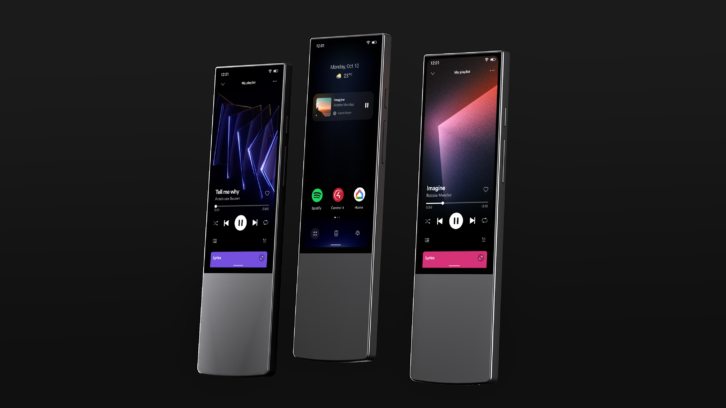
Spotify users will also benefit from the A1’s preset feature. Using the AVA app you can “favorite” a Spotify playlist, album, or artist to one of five presets that can then be recalled by simply tapping the music icon on top of the speaker, no phone or remote needed. This would be a great solution for a guest area where you could pre-load the speaker with five music options (pop, rock, jazz, classical, country) and then let them just toggle through to find their preferred genre. I’d often walk into my office where I installed the system and then give it a tap or two as I walked past the speaker to get some tunes playing, and this was quick, easy, and convenient.
While the remote and speakers can certainly work together, they don’t have to; the speakers function wholly without the remote, and the remote does plenty of things beyond controlling the speakers. I often found myself using my iPhone to control the speakers and using the remote to control my house and Control4 system. I’d love to say there is some special synergy or power-up unlock features when using the remote with the speakers, but (currently) not so much.
Conclusion
I’ve reviewed a lot of streaming audio systems at this point in my career, and one thing I’ve learned is that you can improve and update software and features, sound you can’t. For dealers looking for a premium solution to the traditional wireless offerings, AVA offers something new and unique worth considering.
But I think it is the RX1 that will grab many dealers’ attention, wholly outside the speaker system. The remote offers a premium, luxury looking and feeling control solution that is essentially brand-agnostic and certainly offers a compelling option for guests or kids to use with any system without needing to install an app on a phone.
Dealers looking to find out more can visit ava.com/pro-installers or send an email to [email protected]
Kudos: Remote’s beautiful industrial design and zippy performance; speakers deliver clear, detailed audio; presets offer quick one-touch to music
Concerns: Bass performance and integration; premium pricing for performance/features; works best with Spotify
Product Specs:
A1 Speakers
- Speakers designed and engineered in conjunction with Revox
- Compact wireless streaming audio speakers designed to work as part of a 2.1-channel system with B1 bass module
- Frequency response 52 Hz–20 kHz; max 95 dB/1m output
- 20-watt amplifier (additional 20-watt amplifier for driving P1 speaker)
- Wi-Fi (802.11 a/b/g/n/ac), Ethernet connections; KleerNet for connection to other speakers; Phoenix connector for P1 speaker
- M6 threaded connection for wall-mounting
- Spotify Connect, AirPlay 2, UPnP, Bluetooth, 3.5mm analog line input
- 15 VDC/4A power supply; built-in 2500 mAh Lithium-Ion battery
RX1 Remote
- Aluminum alloy construction with scratch-resistant glass
- 5-inch IPS touchscreen with 480 x 1170 resolution at 280 ppi
- Runs Android 11 OS and Google Play Store
- 32 GB Quad Core 2 GHz
- Includes GPS, microphone, accelerometer, fingerprint sensor, loudspeaker
- Built-in Wi-Fi (802.11 a/b/g/n/ac), Bluetooth 5, NFC
- 2200 mAh Lithium-Ion rechargeable battery with docking station
John Sciacca is a principal with Custom Theater and Audio, in Myrtle Beach, South Carolina. In his free time, he blogs prolifically about the CE industry and is publisher for cineluxe.com.

